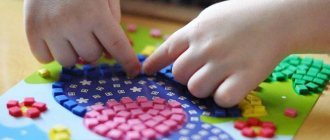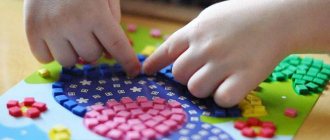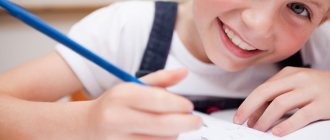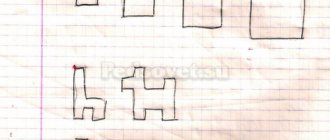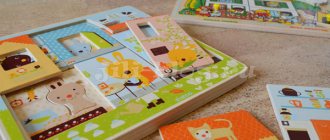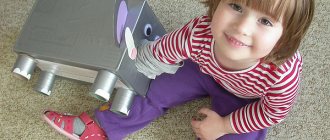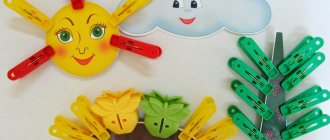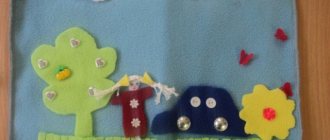Child psychologists have proven that the brain is directly related to a child’s ability to use his hands and fingers and perform various actions with them. That's why parents need to play games with their children to gradually develop fine motor skills. Training should be carried out regularly, be varied and not tire the child.
Definition
Fine motor skills are a set of movements performed by the fingers and hands. It is extremely important to develop it for several reasons.
- Through such activities, the internal organs of the baby are affected. Exercise has a beneficial effect on brain development.
- The ability to perform movements with fingers and hands is most often an indicator that the child is fully developing.
- Finger movements are directly related to speech centers in the cerebral cortex, so experts recommend training your hands in parallel with speech development. Moreover, doing motor skills exercises will help those children who suffer from speech impediments begin to speak better.
Work on fine motor skills should begin from a very early age. Even babies have their fingers massaged, but older children need to learn to perform basic actions on their own. This will be helped by special play exercises that are interesting and useful for kids.
Benefits of exercise
Games and exercises that develop fine motor skills should be carried out with the child on a regular basis, as they not only improve the baby’s ability to work with his fingers and hand, but also stimulate speech development.
Without such activities, there is a risk that the child will be unprepared for school, his hand will not be able to hold a pen or write correctly. And the child himself may find himself helpless and experience difficulties in performing such basic actions as tying shoelaces.
Daily exercise will help improve attention and memory. Gaming technologies are diverse, so any parent can choose exercises to their liking.
When should you start developing fine motor skills?
From birth. During the first month of life, the baby's hands are almost constantly clenched into fists due to hypertonicity. Over the next 2-3 months, the palm gradually straightens. To speed up this process and relieve stress, you should massage your arms, paying special attention to your palms. However, do not overdo it with unclenching your fist - this should be done easily, without effort, and only if the baby does not mind.
Rub your palm, hand, bend your fingers one at a time, massage your joints, shake your pen in the air. Repeat the massage daily at the same time, preferably in the morning.
When your baby learns to grasp rattles or hold your finger, lightly tug on it (or the toy), as if taking it away. Let him learn to control his hand and train his grip strength. Over time, when the hypertonicity completely goes away, you can start playing games with jokes: “Ladushki”, “Magpie-Crow”, “Horned Goat”, etc. Children not only really like them, but also develop fine motor skills - the first purposeful movements of the brush and fingers.
And then everything depends on the parents’ imagination, motivation and availability of free time.
Age
Pediatricians recommend starting conscious daily training with a child who is 4-5 years old. But at an earlier age, fingers need to be given attention - massage, kneading active points that are directly connected to the brain centers.
So, for the youngest (up to 2 years old) the following exercises can be used:
- stroking the palm;
- flexion-extension of fingers;
- clapping your hands.
To make the child have fun, the lesson should be accompanied by reading nursery rhymes about the White-sided Magpie and playing “Ladushki”.
If a child attends kindergarten, then teachers in the younger group conduct classes on the development of fine motor skills, but for parents this is not a reason to refuse home training, which will help consolidate the acquired skills and translate them into skills. Therefore, on weekends you need to work with your baby using a playful form, offering him new interesting tasks.
Games for the development of fine motor skills in preschool children 5-6 years old
Games for developing fine motor skills in older preschoolers
The development of fine motor skills of the hands plays an important role in the overall development of preschool children, allows for the formation of coordination of finger movements, develops speech activity, prepares the child for school, and develops creative abilities.
I bring to your attention a number of simple, but useful and exciting exercises that can complement the games of preschoolers. This material will be useful to kindergarten teachers, speech therapists, and parents of preschool children. 1. Beads Purpose:
to develop precision of movements, consolidate knowledge of colors.
What you need:
colored pasta, long string.
How we play:
we string the pasta onto a string; you can suggest a certain alternation of pasta colors.
2. Exercises with tweezers Purpose:
to develop precision of movements, consolidate knowledge of colors.
What you need:
tweezers, small “buttons” (I made them from moisture-absorbing kitchen napkins using a hole punch), several small bowls.
How to play:
Using tweezers, arrange the “buttons” by color into different bowls (shapes).
3. Exercises with clothespins Purpose:
to develop accuracy of movements and attention.
What you need:
box, clothespins, set of paired pictures.
Glue pictures to the edge of the box and to the clothespins. How to play:
take a clothespin with any picture, find the same picture on the box, attach the clothespin to the edge of the box.
4. Paths Purpose:
to develop precision of movements, the ability to navigate on a sheet of paper.
What is needed:
a sheet of cardboard, natural material (small pebbles, shells, beans, peas), small buttons.
How we play:
on a sheet of cardboard we lay out winding paths with the material of our choice.
5. Laying out along the contour Goal:
to develop precision of movements.
What is needed:
a set of sheets with outline images of objects, colored paper clips, buttons, natural material (shells, small pebbles, beans).
How we play:
offer to choose a figure, lay out a figure along a given contour using the selected material, you can offer to “paint over” the figure.
6. Picture of beads Purpose:
to develop precision of movements, creative imagination.
What you need:
a sheet of cardboard, a set of colored beads.
How to play:
lay out a drawing as desired on a sheet of cardboard.
7. Twisting ribbons Purpose:
to develop precision of movements.
What is needed:
long satin ribbons attached with a small stick glued to the end (for example, an ice cream stick)
How to play:
offer to twist the ribbons from one edge to the other.
8. Openwork pattern Purpose:
to develop precision of movements.
What you need:
a toothpick or skewer, a sheet with a simple design drawn, a letter, a number, or a template cut out of cardboard, fabric folded in several layers.
How to play:
place a sheet with a design on a fabric folded in several layers, the child uses a toothpick or skewer to pierce holes along the contour of the design, and when finished, look at the design in the light.
9. Feed the bird Goal:
to develop precision of movements.
What you need:
a cardboard box with a picture of a bird pasted on it, make a small hole near the beak;
a handful of wheat, beans, peas. How to play:
throw one grain into the hole.
We recommend watching:
Games for the development of fine motor skills in preschool children Development of fine motor skills using the isothread technique Recommendations for parents on the development of fine motor skills Musical warm-up for children in kindergarten
Similar articles:
Exercises to develop fine motor skills in children 6-7 years old
Basics of the development of fine motor skills of the fingers in children of primary preschool age
Summary of joint activities of the teacher and children of the senior speech therapy group on the development of fine motor skills of the hands
Games for the development of fine motor skills in children 2 years old
Rules for performing finger exercises
Working with the baby on the development of fine motor skills should be carried out on a regular basis, but not tire the child. The easiest way to do it is with finger games, which perfectly stimulate the brain and help develop dexterity, attention, and memory. The work is carried out first with the right hand, then with the left. An adult is required to monitor the correct execution of the movements, so before showing them to a child, you need to practice yourself.
Advice
You should start with 2-3 repetitions of each exercise, gradually increasing them to 5-8. Training is carried out daily, and a few minutes a day is enough.
Didactic manuals advise: if the child gets tired, the lesson can be broken up. Do the first two exercises in the morning, two more in the afternoon, and one in the late afternoon.
Most popular games
The game catalog contains a huge number of options. We offer some simple finger games that are loved by most children.
- Squeeze all the fingers on both hands, then unclench them. Run several times.
- Squeeze the fingers on your right hand and unclench them one by one. Repeat the exercise with the left.
To make it interesting for the child, during the lesson the parent can read funny poems to him or write a story about how a fairy-tale character (a bear) got home with the help of finger movements. For example: the bear passed the first forest - extend one finger. The bear passed the second forest - we unbend the second one. The child will try to do the exercise to find out how the fairy tale ends.
- "Fan". The exercise is useful for the fingers; it is performed like this: press your fingers together (imitating a closed fan), then spread them as wide as possible (the fan has opened), and wave your hand.
- A very good exercise that helps develop not only motor skills, but also attention and reaction speed - “Scratch-scratch”. The parent places his hand on the table, the baby places his palm on the adult’s palm and listens to him. Mom or dad tells a poem or a fairy tale, the child’s task is to be attentive. As soon as “tsap-scratch” is heard (this can be any other phrase discussed in advance), he needs to remove his palm as quickly as possible, otherwise the parent will cover it with his other hand. After a few practices, parent and baby can switch roles.
- "Butterfly". First, the fingers are clenched into a fist, now you need to straighten the little finger one at a time, then the ring and middle fingers. Create a ring from the index finger and thumb. The butterfly is ready. Now you need to ask the child to “flap his wings” - make movements with straight fingers.
If one of the finger games causes difficulty, you can replace it with another for a while; you should not torment your child with a mandatory mindset for success.
Examples of finger games
So, the development of fine motor skills in children 3–4 years old begins with the simplest games:
- Actively rub your palms and ask your baby to do the same.
- Show your child how siblings greet each other - the fingers of the same name on your hands: touch each other alternately with your little fingers, ring fingers, middle fingers, index fingers and thumbs, telling your baby that this is how brothers greet each other. Let him try again.
- Let the baby imagine that his index and middle fingers are legs that are stomping along a path (for example, into the forest for sweet strawberries). His fingers should precisely walk along the surface of the table.
- And now let him turn into an old grandmother (grandfather) who cannot see well. The doctor prescribed glasses for them (the child uses his thumb and index fingers to pretend to be glasses, bringing them to his eyes).
A little later, when the baby gets used to such exercises, you can start playing with short rhymes, gradually adding longer rhymes and complex movements.
- boat
A hare is swimming in a boat (the child folds his hands in the shape of a boat),
The little bunny calls to swim with him (the baby waves his hands with inviting gestures).
- cat
How painfully does a baby cat bite?
He decided that he saw not a finger, but a mouse!
But I'm playing with you, baby,
And if you start biting, I’ll say: “Come on, shoot!”
When performing this game, the mother takes an old clothespin with a relaxed clamping mechanism so that it does not catch painfully, and “bites” each of the child’s fingers in turn.
- Curlers
The essence of this game is to bend each finger on the baby's hand in turn. To do this, you can use a variety of nursery rhymes. For example, these:
This finger is daddy.
This finger is mommy.
This one here is a grandpa.
This is grandma.
Well, this finger is me.
That's my whole family!
(You need to start counting with your thumb to finish with your little finger)
This brother found a fungus.
It began to cut him.
It was my brother who was frying a mushroom.
This one just ate and ate,
Look how fat he has become!
(Counting, on the contrary, starts with the little finger and ends with the thumb).
First lessons with objects
Having learned the basic games with fingers, you can move on to the next step - practicing with objects. For the little ones, such developmental exercises will be useful.
- Working with a pencil and small hair ties. The parent holds a pencil in his hand. The child’s task is to put several small rubber bands on him one after another.
- Drawing with semolina. The parent pours a thin layer of cereal onto a flat plate or cutting board, inviting the baby to run his finger over it. You will get a line. In the same way, the child draws several stripes on the semolina.
- Laying out the beans. The mother gives the baby a small handful of beans (beads or buttons can replace them). The preschooler is required to lay it out on the table in piles or make a path.
- Working with beads, stringing large elements. They can be replaced with pasta pre-dyed in different colors.
- Working with buttons. The parent draws a circle on a piece of paper. The child is given instructions to arrange buttons, paper clips, and beans along its contour.
- Children love to imitate adults, and this should be used in organizing classes. So, the mother can invite the baby to stir the sugar in his tea himself.
- "Firework". The baby’s task is to tear a sheet of paper into as small pieces as possible and fold them on the table. Then these scraps are held in the hands and tossed, like a real fireworks display.
The main rule is to practice every day, but do not force the baby. Training should bring joy, not irritation.
A collection of games and exercises for developing fine motor skills
Natalya Shardakova
A collection of games and exercises for developing fine motor skills
We play, we play - we develop
Compiled by: Shardakova N.P., teacher.
“The origins of children’s abilities and gifts are at their fingertips. From them, figuratively speaking, come the finest streams that feed the source of creative thought. The more confidence and ingenuity in the movements of a child’s hand, the more subtle its interaction with the tool, the more complex the movements necessary for this interaction, the brighter the creative element of the child’s mind. The more skill in a child’s hand, the smarter the child.”
V. A. Sukhomlinsky
Games with fingers and hands stimulate the process of speech and mental development of children , develop fine motor skills of the fingers and coordination of movements. Such fun is very exciting. They promote the development of creative activity.
The collection includes exercises and games for the development of children's fine motor skills using various toys and games, factory-made or independently made from scrap and waste materials. Ordinary objects that can be used for play, involving the child in helping with housework.
The collection is recommended for teachers of children's homes, junior kindergartens and parents.
There are many toys on sale that are very useful for developing fine motor skills . Among them, for example:
• sorters” (cubes with holes of different shapes and inserts of different shapes)
– you can do it yourself by cutting holes in a cardboard box and inviting the child to put corks, lids from jars, etc. into the holes);
• lacing – you can do it yourself by taking cardboard and laces;
wooden frames - “puzzles”
and inserts for them with a handle
(usually in the form of apples, bananas, etc.)
;
• wax crayons ;
• kits for creating paintings, beads, etc. from small plastic tubes or beads;
•puzzles:
• mosaics;
• pyramids;
• matryoshka;
• designers;
• small animal toys , cubes, cars;
• box or “magic bag”
, where by touch you need to find an object by agreement or grope and describe the object.
You can make it yourself or buy it;
• finger paints, depending on the manufacturer - some can be used as early as a year.
A variety of subject-based activities have also proven themselves well, which also contributes to the development of fine motor skills .
Some ideas for developing fine motor skills :
• Finger drawing on a tray (mirror)
with cereal, jelly, shaving cream.
• Stringing clothespins on ropes, edges of plates.
• "Sprinkling"
- sand, sugar, semolina.
• Pouring water from one vessel to another; pouring loose objects (cereals)
from one vessel to another.
You can spray water into toys using a plastic (disposable)
syringe without a needle.
• Playing with water and a soft sponge.
• Pulling thread out of fabric.
• Applique (tear off pieces of thin paper or cotton wool and glue to the base;
• working with natural materials (cones, acorns, leaves, etc., small objects (buttons, rhinestones, shells)
– gluing using plasticine.
• Catching small toys from the bath using a spoon or ladle.
•Learning to unscrew lids: open a screw-on jar; open tubes of toothpaste and bottles;
• open a box of matches with some interesting small item or tasty treat inside;
• push the pencil, drop the beans into an empty plastic bottle;
• open and close markers, felt-tip pens.
• In everyday life, the child must learn to fasten and unfasten buttons and zippers
,
Velcro
, lace up shoes, roll up sleeves.
• An empty plastic soda bottle. You can fill it with beads and rattle it, or you can stick a pencil in it or lower the beads.
• Empty yogurt containers. You can cut them into rings and put them on the pegs.
• Cardboard tubes used for paper towels or toilet paper. Can be used as "pegs"
for putting on rings or as
“tunnels”
for cars.
• Empty bottles with a dispenser, like dishwashing detergent. Wash them well and use them for bath play.
• Wrist bracelets. Wearing a bracelet across the entire hand develops children's sense of touch.
• The child dips his hands into a vessel filled with some homogeneous filler (water, sand, various cereals, pellets, any small objects , and for 2-3 minutes he seems to mix the contents. Then he is offered a vessel with a different filler texture. After several tests, the child with closed eyes, he lowers his hand into the offered vessel and tries to guess its contents without feeling its individual elements with his fingers.
• Retrieving toys from the cereal pool will be a useful and fun activity. To make such a pool, you need to pour in cereals (peas, beans, wheat, pearl barley)
in the basin, put various toys
(preferably not very large)
and invite the baby to find the toys in this pool.
This play exercise not only promotes the development of fine motor skills , but also massages the baby’s hand and develops his tactile sensations.
• Take a bright tray. small grains onto a tray in a thin, even layer . Run your baby's finger over the rump. You will get a bright contrasting line. Let your child draw a few chaotic lines himself. Then try to draw some objects together (fence, rain, waves)
etc.
• Choose buttons of different colors and sizes. First, lay out the drawing yourself, then ask your child to do the same on his own. After the child learns to complete the task without your help, invite him to come up with his own versions of the drawings. You can use a button mosaic to make a tumbler, a butterfly, a snowman, balls, beads, etc.
• Give your child a round hair brush. The child rolls the brush between his palms, saying:
"At the pine, at the fir, at the Christmas tree
Very sharp needles.
But even stronger than the spruce forest,
The juniper will prick you.”
• Take a sink grate (usually it consists of many squares)
. The child walks with his index and middle fingers, like legs, along these cells, trying to take steps on each stressed syllable. You can “walk” alternately with one hand and then with the other, or you can do it with both at the same time, saying:
"We wandered around the zoo,
Each cell was approached
And they looked at everyone:
Bear cubs, wolf cubs, beaver cubs.”
• Take the dumpling maker. Its surface is similar to a honeycomb. Baby with two fingers (index and middle)
depicts a bee flying over a honeycomb:
“Fingers, like bees, fly through the honeycombs
And they enter each one with a check: what is there?
Will we all have enough honey until spring?
So that you don’t have hungry dreams?”
• Pour 1 kg of peas or beans into a pan. The child puts his hands in there and imitates kneading dough, saying:
“Knead, knead the dough,
There is room in the oven.
They will be out of the oven
Buns and rolls."
• Pour dry peas (beans)
. For each stressed syllable, the child transfers the peas, one at a time, to another mug. First with one hand, then with both hands at the same time. Any quatrains can be selected.
• Pour in peas (beans)
on a saucer.
The child takes a pea with his thumb and forefinger and holds it with the other fingers (as when picking berries , then takes the next pea, then another and another - so he picks up a whole handful. You can do this with one or two hands.
• Place two caps from plastic bottles on the table threaded up. These are “skis”. The index and middle fingers stand in them like feet. We move on the “skis”, taking one step for each stressed syllable:
“We are skiing, we are rushing down the mountain,
We love the fun of cold winter."
• We build a “log house” from matches or counting sticks. The higher and smoother the log house, the better.
• Clothespin (check on your fingers to make sure it's not too tight)
alternately “bite” the nail phalanges
(from the index to the little finger and back)
on the stressed syllables of the verse:
“The silly kitten bites hard,
He thinks it's not a finger, but a mouse. (Change hands.)
But I'm playing with you, baby,
And if you bite, I’ll tell you: “Shoo!”
• We stretch the rope at the level of the child’s shoulders and give him several clothespins. For each stressed syllable, the child attaches a clothespin to the rope:
“I’ll pin the clothespins deftly
I’m on my mother’s rope.”
• The child crumples a handkerchief (or plastic bag)
so that it all fits in your fist.
•The child rolls a walnut between his palms and says:
"I'm rolling my nut,
To become rounder than everyone else.”
• The child holds two walnuts in one hand and rotates them around one another.
• Modeling from salt dough.
Here is the recipe for salt dough:
1 cup flour, 3/4 cup salt, 5 tbsp. spoons of vegetable oil,
a little warm water, a little starch.
For color, you can add gouache, beet or carrot juice to the dough.
Dissolve salt in a minimum amount of water, knead everything together.
The dough can be used repeatedly and stored in the refrigerator in a closed jar.
To harden, place the figurine in a cold oven and bake over medium heat. Cooled figures can be painted and varnished.
• Exercises with dough:
Pinch off pieces with two fingers, then stick them on (for example, eyes)
.
Clap the dough, flatten it with your whole palm, roll sausages with your palm and each of your fingers.
Imprint fingers and chopsticks on the dough.
Combine dough with other materials (peas, beans, twigs, vermicelli, straws)
You can make rings and string them on a cord.
• Small screw-on bottles (game for children 2-3 years old)
Hide small toys or candy , and leave some of the bottles empty. Invite your child to guess in which bottles the toys are hidden. It will be very good if he himself thinks of shaking the bottle and listening to see if there is anything there. Once all items have been removed, ask your baby to close the bottles.
The game develops auditory attention and fine motor skills .
• Cream jars (game for children 2-3 years old)
Invite your child to unscrew all the caps, and then, after mixing them, close them again. You can play with three to five jars or more. Please note: all jars must be different, so that only a different lid fits each one.
The game develops visual perception, visual memory, fine motor skills .
• Clothespins (game for children 3-5 years old)
Attach clothespins to a cardboard circle to create a “sun”
or
"flower"
. You can design the toy in the shape of a hedgehog, with clothespins acting as needles. Invite your child to remove all the clothespins and then reattach them. If there are a lot of clothespins, they are of different colors and configurations, then the children themselves can come up with a lot of crafts.
The game develops fine motor skills and hand-eye coordination.
Here are exercises in which a baby can train fine motor skills , helping parents and feeling needed and almost an adult:
• Remove the skin from vegetables cooked in their skins. Peel hard-boiled eggs. Peel tangerines.
• Pick up debris from the floor. Help collect objects scattered on the floor (buttons, carnations, beans, beads)
.
• Help wind threads or rope into a ball (it’s better to keep silent about who unwound them)
.
• Polish shoes for the whole family with a special sponge.
• Help parents unscrew various caps - water cans, bubble baths, toothpaste, etc.
• Help sort out the cereal.
• Tear, crumple paper and stuff it into shoes being stored.
• Wipe away dust without missing anything.
• Turn lights on and off.
• Look for the edge of the tape. Peel and stick stickers.
• Turn the pages of a book.
• Sharpen pencils (with a sharpener)
. Erase the drawn scribbles with an eraser.
• Pour liquids from one container to another.
• Play with mosaics and puzzles.
• Sort buttons or other items by size.
• Collect construction sets.
• Place objects in narrow openings, such as the neck of a bottle.
• Model together from plasticine.
• Paint. Holding pencils and brushes in your hands is an excellent way to develop motor skills , no worse than special exercises . Teach your child to trace drawings and objects along the contour. Paint not only with brushes, but also with your fingers. Now there are special paints for this.
• Cut out different shapes from paper.
• Motor skills are also developed by other simple and familiar activities - braiding hair, combing dolls, putting toys in their places and much more.
• While walking, build castles, slides, and other figures from sand or pebbles. Coarse sand and stones develop palms .
• Invite your child to help you with the housework - making dumplings, kneading dough, weeding beds, sewing, picking berries - a great alternative to games.
• Buy soft toys filled with small balls . They are designed specifically for the development of children's fine motor skills .
• Always play with toys of different sizes, shapes and sizes.
Basic games
Parents should prepare in advance a set of games that will help their 4-5 year old child develop the ability to work with fingers and perform small movements. There are a great variety of similar exercises; almost all the tools can be created from improvised means.
You can offer the following options for exciting games.
- With cereals and large objects (for example, a button, a bead). The parent takes a deep bowl, fills it with cereal, into which he buries several buttons. The baby’s task is to find and get them.
Advice
For this exercise, you can use almost any cereal: rice, peas, buckwheat.
- Untying knots. You need to start with simple ones, using a thick rope, gradually complicating the task.
- Labyrinth. An adult draws a “labyrinth” on a piece of paper, and the child’s task is to walk through it with the index and middle fingers, imitating steps.
These exercises develop the hand and fingers well.
How fine motor skills develop
The motor skills of a five-year-old and an infant are significantly different. Babies are just learning to control their hands, having only a grasping reflex in their arsenal. Later it transforms into a purposeful gesture that will allow the child to reach his favorite rattle, and then get to his feet.
During infancy, fine motor skills develop through tactile perception. The baby enjoys running his fingers over objects with different textures and learns to recognize information that is transmitted through sensations. At this time, a powerful foundation is laid for further development and a fulfilling life, because the ability to feel the texture of an object with our fingertips allows us to navigate in the dark, play musical instruments, etc.
- By the end of the first year of life, the baby firmly holds small objects, knocks toys on a hard surface, and knows how to lay out and assemble a pyramid.
- From 2 to 3 years old, palm movements actively develop, and grasping of an object with the index and thumb appears.
- At 3-4 years old, the baby’s hand movements are coordinated and aimed at solving a specific problem. He can spend a long time drawing, sculpting, buttoning and unbuttoning clothes.
- From the age of 5, a child can easily handle a zipper, tie shoelaces, can independently untie a knot, work with scissors, and draw straight lines and geometric shapes.
We make exercise equipment
To teach a child to use a brush and make movements with his fingers, parents will have to try and be patient, because not everything will work out the first time. To prevent your baby from losing interest, it is important to offer him a variety of exercises. Therefore, moms and dads will have to create exercise equipment with their own hands. There are many options.
The bird is made like this:
- take a cardboard box (for example, pizza, candy).
- an image of a bird is applied to it, preferably large in size (the bird can be pasted on or drawn);
- A hole is made in the cardboard near the beak.
The baby’s task is to lower one grain into the hole (to feed the bird).
In a similar way, you can feed the worm peas.
A simulator with bands can be done like this:
- several satin ribbons are attached to a vertical surface (you can sew them to a special rug, which you hang on the wall so that the baby can easily reach it);
- A small wooden stick is glued to the other side of each ribbon (you can use a popsicle stick).
The child’s task is to try to twist the ribbon.
Children are also very fond of homemade lacing, exercises with which contribute to the formation of a very important skill - lacing shoes.
You can make an interesting activity yourself from felt - cut out a hedgehog figurine and fruit, inviting your child to place the “prey” on the hedgehog’s spines.
You can purchase special educational toys in the store - construction sets, mosaics, puzzles, pyramids, and a magic basket.
Safety precautions
To ensure that games aimed at developing fine motor skills do not cause harm to the baby, parents should follow the following rules.
- After the lesson, carefully remove all small objects so that a curious child, having discovered a familiar “entertainment”, does not accidentally swallow it or stick it in his nose or ear.
- During the training, the baby must be supervised. It is important for an adult to control literally every movement, because the child does not yet understand that he can harm himself.
These simple rules will help you avoid accidents.
The development of fine motor skills with the help of didactic games and exercises should become a habit for both parents and children. It is necessary to train with your child every day, coming up with new stories and using a variety of available means.
The importance of fine motor skills
Fine motor skills of the hands are a unity of coordinated manipulations that are aimed at performing small precise movements with the hands and fingers. Just a few decades ago, parents did not have problems with the motor skills of their children. After all, the children did a lot of things with their own hands: they helped peel vegetables, make pies, do laundry, sort out cereals, tie shoelaces and fasten buttons. Today, most of these activities are done either by adults, allowing children to play, or by specialized machines. Even Velcro shoes and clothes with zippers deprive the child of the opportunity to practice the fine movements of his fingers.
Meanwhile, a lot says about the importance of fine motor skills. Children with weak motor skills are not ready for writing and often lag behind in speech development. All this affects school performance and leads to increased stress on the child’s nervous system.
Among other things, the state of fine motor skills of the hands directly affects the development of the child:
- self-care skills;
- perseverance;
- thinking;
- attention;
- imagination;
- vocabulary;
- memory.
After all, the centers of the cerebral cortex responsible for fine motor skills are adjacent and closely interconnected with the centers responsible for the development of these areas. By activating the fine motor area, we naturally influence the neighboring ones.
